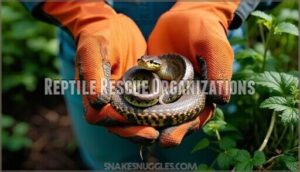This site is supported by our readers. We may earn a commission, at no cost to you, if you purchase through links.

Start by checking nearby animal shelters, as they occasionally house surrendered reptiles. Reptile-specific rescues offer better expertise and health histories.
Online adoption sites expand your search radius substantially, connecting you with foster families and rescue organizations within driving distance. Local reptile societies and herpetological clubs often know members rehoming their snakes responsibly.
Cast a wide net early since adoptable corn snakes find homes quickly. These gentle, low-maintenance reptiles make excellent pets when you know where to look and what questions to ask potential matches. They are ideal for those seeking a pet that is easy to care for, and with the right guidance, you can find the perfect corn snake to join your family.
Table Of Contents
- Key Takeaways
- Preparing for Corn Snake Adoption
- Finding a Corn Snake for Adoption Near You
- Understanding Corn Snake Needs and Care
- Choosing The Right Corn Snake for Your Experience Level
- Factors to Consider for Beginners
- Characteristics of a Good Pet Snake
- Choosing a Snake That Fits Your Lifestyle
- Avoiding Common Mistakes in Snake Selection
- Ensuring a Smooth Transition for Your New Pet
- Testimonials From Experienced Adopters
- Online Communities for Snake Owners
- Ongoing Education and Support for Snake Care
- Frequently Asked Questions (FAQs)
- What should I do with a corn snake?
- Can corn snakes live with other snakes?
- Should you adopt a snake?
- What should I give my corn snake to hide in?
- How can you help a corn snake shed properly?
- Can snake discovery take in XL reptiles?
- What is the average lifespan of a corn snake?
- What is the biggest trouble with corn snakes as pets?
- Is a 40 gallon tank big enough for a corn snake?
- What not to do with a corn snake?
- Conclusion
Key Takeaways
- You’ll find corn snakes for adoption through local animal shelters, reptile rescues, online platforms like Petfinder and MorphMarket, and reputable breeders who offer rehoming services with adoption fees typically ranging from $60-100.
- You need to prepare a proper habitat before bringing your snake home, including a 50-gallon tank with temperature gradients of 88-90°F on the hot side and 72-75°F on the cool side, plus secure hides and appropriate substrate for burrowing.
- You should budget $15-30 monthly for ongoing care including frozen mice ($10-12), heating costs, and substrate replacement, while also establishing a relationship with an exotics veterinarian who understands reptile-specific needs.
- You’ll want to choose a corn snake that matches your experience level and lifestyle, as these docile reptiles live 15-20 years and require consistent weekly feeding schedules and temperature monitoring throughout their lifespan.
Preparing for Corn Snake Adoption
Before you bring home your corn snake, you’ll need to prepare the right habitat, understand care requirements, and budget for ongoing expenses.
Proper preparation guarantees your new pet moves smoothly into their environment and helps you avoid common mistakes that new snake owners often make, ensuring a successful transition with proper preparation.
Researching The Right Snake for You
Choosing the right corn snake for adoption requires careful consideration of your lifestyle and preferences.
These docile reptiles make excellent companions, but matching your expectations with reality guarantees success.
Choosing the right corn snake means finding a pet that perfectly matches your lifestyle and experience level.
Key factors to research before corn snake adoption:
- Size Expectations – Adult corn snakes reach 4-6 feet, requiring appropriate enclosure space and handling confidence.
- Morph Considerations – Different color patterns don’t affect temperament, so choose based on visual preference.
- Activity Level – Corn snakes are primarily diurnal, being most active during daylight hours when you’re likely home.
Consider your handling frequency preferences and temperament matching needs when selecting your future reptile companion.
Understanding Corn Snake Temperament
Once you’ve narrowed down your search for corn snake adoption, understanding their temperament becomes your next priority.
Most corn snakes fall somewhere between docile and skittish personalities. Individual variation means each snake from a corn snake rescue will have unique traits.
Some readily accept handling techniques, while others need patience to warm up. Reading body language helps you spot stress signals like coiling tightly or rapid tongue flicking.
Temperament changes can occur with age, illness, or environmental stress. When you adopt a corn snake from reptile adoption centers, ask about their specific personality to guarantee compatibility with your snake adoption near me goals.
Creating a Suitable Environment
Setting up your corn snake’s perfect home requires attention to key details.
Start with proper temperature gradients – maintain 88-90°F on the hot side and 72-75°F on the cool side.
Provide secure hides and security on both ends for comfort.
Choose appropriate substrate choices like aspen shavings for burrowing.
Many owners utilize under tank heaters to achieve the correct temperatures.
Add enrichment options like branches and consider minimal lighting needs for your corn snake habitat.
Estimating Monthly Costs
Budget around $15-30 monthly for your corn snake’s essentials after reptile adoption near me.
Food costs include frozen mice at $10-12, while heating costs and substrate replacement add another $10-15. Factor in occasional vet expenses and enrichment budget for a happy pet.
Monthly corn snake expenses you’ll encounter:
- Frozen prey – Your snake’s weekly dining budget
- Heat lamp electricity – Keeping your scaly friend cozy
- Fresh bedding – Clean substrate for burrowing comfort
Lifestyle Changes to Expect
After budgeting comes the reality check: your life’s about to shift gears. Corn snake adoption brings schedule adjustments you hadn’t considered.
Weekend getaways become trickier with travel limitations, and your social life might revolve around feeding days. Your home environment transforms into a reptile haven, while personal habits adapt to snake rhythms.
| Lifestyle Area | Before Snake | After Adoption |
|---|---|---|
| Travel | Spontaneous trips | Pet-sitter needed |
| Schedule | Flexible weekends | Feeding routines |
| Social Plans | Any time works | Consider snake needs |
| Home Space | Human-focused | Pet snake adoption setup |
Finding snake rescue near me or reptile rescue options helps ease this shift into responsible ownership.
Finding a Corn Snake for Adoption Near You
You’ll find corn snakes available for adoption through multiple sources, including local animal shelters, reptile rescues, online platforms, and specialized breeders who offer rehoming services.
Start your search by checking nearby shelters and rescue organizations, as they often house surrendered corn snakes with adoption fees typically ranging from $60 to $100, which can be considered a reasonable cost for adopting a pet, and the process usually involves rehoming services.
Local Animal Shelters and Rescues
Your local animal shelter might surprise you with available corn snakes needing homes.
Many shelters offer thorough shelter vetting and rehoming support for surrendered reptiles.
Adoption fees typically range from $60-100, covering basic care costs.
Contact nearby facilities about their surrender options and rescue resources.
These community hubs often partner with specialized reptile rescue organizations to guarantee proper snake rescue near me services, ensuring a smooth rehoming process.
Reptile Rescue Organizations
Specialized reptile rescue organizations dedicate their rescue mission to corn snakes and exotic pets.
These groups understand the surrender process and often engage in fostering reptiles while providing rehabilitation efforts.
You’ll find detailed adoption fees that support their work.
Organizations like Forgotten Friend Reptile Sanctuary and Nate’s Reptile Rescue offer exotic pet adoption services.
When searching "where to adopt snake," these reptile rescue organizations provide the expertise and care corn snakes need.
Online Platforms for Snake Adoption
Beyond reptile rescue organizations, online platforms open doors to corn snake adoption opportunities across wider geographic areas.
These digital marketplaces connect you with verified sellers and adoption agencies nationwide.
MorphMarket leads the pack with detailed health guarantees and seller verification systems. PetFinder specializes in exotic pet adoption through shelter partnerships. FaunaClassifieds offers extensive support resources and community feedback. Reptile Forums provide platform reputation insights from experienced adopters.
Always verify adoption fees upfront and confirm listing accuracy before committing.
These platforms maintain strict standards, ensuring your future companion comes from ethical sources with proper documentation.
Reputable Breeders for Adoption
Reputable corn snake breeders offer another pathway to adoption beyond rescue organizations.
Look for Breeder Reputation through online reviews and references from previous buyers.
Ethical Breeding practices guarantee healthy snakes with proper Lineage Tracking and documented genetics.
Quality breeders provide Health Guarantees and demonstrate Breeder Transparency about their animals’ backgrounds.
When searching "corn snake for sale" or researching corn snake breeders, prioritize those who support reptile rescue efforts and genuinely care about placing snakes in forever homes.
Health Guarantees health guarantees do you offer?"
ethical practices do you follow?"
Engaging With Local Pet Communities
Building connections within your local pet community opens doors to corn snake adoption opportunities you might otherwise miss.
These networks become your go-to resource for finding reputable sources and getting hands-on advice from experienced snake owners.
- Local Reptile Groups host monthly meetings where members share adoption leads and care tips
- Educational Workshops at pet stores teach proper corn snake handling and husbandry basics
- Adoption Events connect you directly with reptile rescue organizations seeking loving homes
- Volunteer Opportunities at rescue centers let you interact with snakes before committing to adopt
Understanding Corn Snake Needs and Care
Before you bring home your adopted corn snake, you’ll need to understand their specific care requirements to guarantee their health and happiness.
Proper housing, feeding schedules, and veterinary care form the foundation of responsible corn snake ownership that can provide decades of companionship.
This foundation is crucial for the health and well-being of your pet.
Dietary Needs and Feeding Schedule
Getting your corn snake’s diet right sets the foundation for a healthy, happy pet.
These carnivores thrive on whole feeder rodents like mice and rats.
Prey size should match 1-1.5 times your snake’s body width, while feeding frequency depends on age.
| Age Group | Feeding Schedule |
|---|---|
| Juveniles | Every 5-7 days |
| Adults | Every 10-14 days |
| Breeding females | Every 7-12 days |
Frozen-thawed meals offer convenience and safety over live prey.
Many owners source high quality feeders for their snakes.
Most corn snakes don’t need supplementation, but monitor for obesity risks by tracking weight regularly.
Providing a Stimulating Environment
Your corn snake needs more than just food and water to thrive. Creating an enriching environment keeps your adopted companion mentally stimulated and physically healthy. Think of it as designing their dream home where they’ll spend their entire life.
- Hides importance: Provide secure retreats on both warm and cool sides
- Climbing branches: Add cork bark or sturdy wood for vertical exploration
- Burrowing substrate: Use aspen shavings 1-2 inches deep for natural digging behavior
- Enrichment ideas: Include artificial plants, textured surfaces, and varied hiding spots
- Lighting options: Consider ambient room light or optional UVB for bioactive enclosure setups
Providing appropriate snake hide options is essential for their well-being.
Establishing a Relationship With a Veterinarian
Your corn snake’s health depends on finding the right exotics veterinarian who understands reptile-specific needs.
Finding the right reptile vet is like discovering a treasure – essential for your snake’s lifelong health and happiness.
Not all vets handle snakes, so research vet qualifications through the Association of Reptile and Amphibian Veterinarians. Schedule your first appointment within weeks of adoption to establish care protocols and discuss emergency procedures.
| Veterinary Aspect | What to Look For | Red Flags |
|---|---|---|
| Qualifications | ARAV membership, reptile experience | General practice only |
| Emergency Protocols | After-hours availability, clear procedures | No emergency plan |
| Regular Checkups | Annual exams recommended | Dismisses routine care |
| Building Trust | Patient explanations, welcomes questions | Rushed appointments |
Preventative Measures for Health Issues
Like a guardian protecting their castle, you’ll shield your adopted corn snake from health troubles through smart prevention.
Quarantine protocols separate new arrivals from existing pets.
Maintain proper shedding conditions with adequate humidity.
Practice strict hygiene practices when handling.
Monitor temperature gradients daily and verify diet quality with appropriately-sized frozen prey.
Your exotics veterinarian becomes your trusted ally in corn snake care.
Emergency Preparedness and Planning
Disasters don’t wait for convenient timing. Keep a secure carrier ready for evacuations and power outages.
Stock first aid supplies and backup heat sources. Create an evacuation plan with alternate housing locations.
Connect with local reptile rescue groups who handle reptile surrender and reptile rehoming. Their expertise proves invaluable during emergencies when reptile adoption centers assist with surrendered snakes.
Choosing The Right Corn Snake for Your Experience Level
Your experience level plays a vital role in selecting the right corn snake, as beginners benefit from younger, more docile specimens while experienced handlers can manage larger or more challenging snakes.
Consider factors like the snake’s age, temperament, and specific care requirements to confirm you’re prepared for the long-term commitment of 15-20 years, which is a significant aspect of owning a corn snake, emphasizing the need for careful consideration of the snake’s temperament.
Factors to Consider for Beginners
Adopting your first corn snake requires thoughtful preparation beyond just wanting a cool pet. Smart beginner research starts with understanding what you’re signing up for long-term. These docile snakes live 15-20 years, so you’re making a serious commitment.
Before you adopt a corn snake, consider these key factors:
- Temperament matters: Corn snakes are generally calm, but individual personalities vary
- Enclosure essentials: Adult snakes need 50-gallon tanks with proper heating zones
- Cost awareness: Initial setup costs $200-400, plus ongoing feeding expenses
- Lifestyle changes: Weekly feeding schedules and temperature monitoring become routine
- Care guide commitment: Learning proper handling and health monitoring takes time
Characteristics of a Good Pet Snake
When you’re ready to adopt corn snake companions, focus on key traits that make exceptional pets.
Look for captive bred specimens with docile temperament and handling ease.
A good corn snake displays calm behavior during interactions and maintains manageable size throughout its lifespan.
Baby corn snake or adult, prioritize low maintenance varieties.
Various corn snake morphs offer stunning patterns while maintaining gentle dispositions.
Healthy specimens from reptile adoption centers typically show consistent feeding responses and clear eyes.
docility
vet checks
Choosing a Snake That Fits Your Lifestyle
Temperament matching starts with honest self-reflection about your household’s energy level. A calm corn snake suits busy families who prefer low-maintenance pets, while more active snakes work well for dedicated handlers seeking regular interaction.
Consider these lifestyle factors:
- Space Requirements: Verify adequate room for a 40-gallon enclosure
- Time Commitment: Weekly feeding plus monthly habitat maintenance
- Handling Frequency: Match snake’s temperament with family interaction preferences
Avoiding Common Mistakes in Snake Selection
Many first-time adopters fall into predictable traps when selecting their corn snake. Morph Considerations shouldn’t overshadow basic health factors – flashy patterns don’t guarantee a healthy pet. Temperament Myths persist, with people assuming all corn snakes behave identically.
You’ll encounter Size Expectations issues too; hatchlings grow quickly and need larger enclosures within months. Always request Health History documentation from any reptile rescue.
Without proper Handling Experience, you might choose a defensive snake that’s overwhelming for beginners. The reptile adoption process requires patience – don’t rush decisions.
Most reptile adoption requirements exist for good reasons. Understanding reptile surrender stories helps you avoid similar mistakes. Choose based on care requirements, not appearance alone.
Ensuring a Smooth Transition for Your New Pet
Your corn snake’s reptile adoption process doesn’t end at pickup.
Create a stress-free environment through these essential steps:
- Initial Quarantine – Isolate your new snake for 30 days to monitor reptile health
- Settling In – Allow 5-7 days before first handling to reduce stress
- Bonding Process – Start with brief, gentle handling techniques
- Reptile Enclosure setup – Make certain proper temperatures are maintained before arrival
- Routine establishment – Maintain consistent feeding and care schedules
These steps are crucial for the well-being of your corn snake, ensuring a smooth transition into its new environment.
Testimonials From Experienced Adopters
Adoption experiences from seasoned corn snake owners reveal heartwarming bonding stories and unexpected joys.
These reptile adoption testimonials show how patient handling builds trust over months.
Advice shared includes letting your snake explore safely and celebrating small milestones.
Reptile adoption success stories highlight overcoming challenges like feeding difficulties, proving that reptile adoption benefits extend far beyond companionship.
Online Communities for Snake Owners
Finding your tribe in online snake communities makes the adoption journey less intimidating.
These digital spaces connect you with experienced owners who’ve navigated corn snake adoption and reptile rescue successfully.
- Reddit’s r/snakes – Share photos, get healthcare advice, and learn forum etiquette
- Facebook groups – Connect with statewise reptile rescues and local reptile organizations
- MorphMarket forums – Discuss morphs identification and breeding practices
- Specialized communities – Access species-specific guidance for reptile adoption
Ongoing Education and Support for Snake Care
Building connections with fellow snake enthusiasts creates lasting support for your corn snake journey.
These communities provide advanced husbandry techniques, morph identification guides, and breeding ethics discussions.
You’ll find genetic health resources and community building opportunities that strengthen your reptile care knowledge.
Online forums, local reptile groups, and educational workshops offer ongoing reptile education beyond basic care, ensuring your corn snake thrives.
Snake Care
Snake Behavior
Snake Handling
Snake Diet
Frequently Asked Questions (FAQs)
What should I do with a corn snake?
Slithering into snake ownership? You’ll need a secure 50-gallon tank with proper heating, hiding spots, and weekly rodent meals.
Handle gently, maintain temperatures between 72-90°F, and provide fresh water for your new scaly companion, ensuring a suitable environment with proper care.
Can corn snakes live with other snakes?
No, you shouldn’t house corn snakes together.
They’re solitary creatures who prefer living alone and can become stressed when cohoused.
Individual enclosures guarantee each snake gets proper food, space, and reduces disease transmission risks.
Should you adopt a snake?
You should adopt a snake if you’re committed to 15-20 years of care, have proper housing setup, and understand their specific needs.
They’re rewarding pets for dedicated owners who appreciate their calm nature.
What should I give my corn snake to hide in?
Coincidentally, your corn snake’s hiding needs match what makes you feel secure at home.
Provide two hides with small openings—one on the warm side, one cool.
Commercial reptile hides, overturned flower pots, or cork bark work perfectly to meet these needs, ensuring your snake has a secure environment.
How can you help a corn snake shed properly?
You’ll need to maintain proper humidity levels around 50-60% and provide a humid hide filled with damp moss.
Don’t handle your snake during shedding, and make certain they’ve rough surfaces to rub against.
Can snake discovery take in XL reptiles?
Picture yourself carrying a massive python or iguana – that heavyweight champion needs a new home.
You’ll want to contact Snake Discovery directly about their XL reptile intake policies, as size limitations vary by facility capacity and resources, including their ability to handle size limitations.
What is the average lifespan of a corn snake?
You’ll find your corn snake can live 15-20 years in captivity with proper care, substantially longer than their 6-8 year lifespan in the wild.
That’s decades of companionship when you provide appropriate housing and nutrition.
What is the biggest trouble with corn snakes as pets?
An ounce of prevention beats a pound of cure—corn snakes are notorious escape artists who’ll slip through surprisingly small gaps.
You’ll need secure, tight-fitting lids and vigilant enclosure checks to prevent costly adventures, as they are notorious for requiring secure measures to keep them from escaping.
Is a 40 gallon tank big enough for a corn snake?
A 40-gallon tank works for younger corn snakes, but you’ll need to upgrade to a 50-gallon breeder tank once your snake reaches adult size of 4-6 feet for proper comfort.
What not to do with a corn snake?
Ever wonder what mistakes could harm your scaly friend?
Don’t use pine or cedar shavings, heat rocks, or red lights.
Never house corn snakes together, skip thermostats, or handle during shedding periods.
Conclusion
Successfully traversing corn snake adoption near me requires patience and thorough preparation.
You’ll discover these remarkable companions through shelters, rescues, and online platforms when you cast a wide search net.
Remember that proper habitat setup, veterinary care, and ongoing education form the foundation of responsible ownership.
Your dedication to research and preparation guarantees you’ll provide a loving home while gaining a fascinating, low-maintenance pet that brings years of quiet companionship and learning opportunities.

















